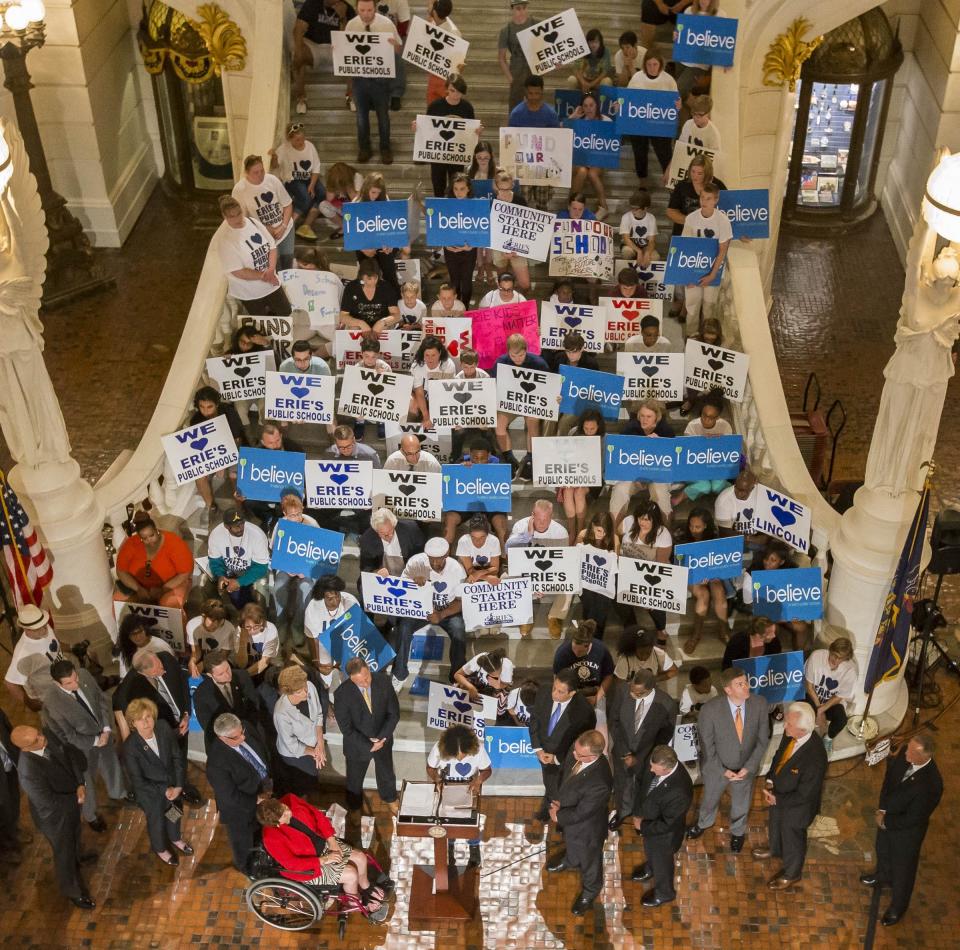Polito: Pa. school funding reforms shortchange districts like Erie, lawmakers must act
How do you save a school district on the brink of financial collapse?
Erie's Public Schools is a case study in how grassroots community support, political will and smart investment in research-based solutions can begin to transform one of the poorest, most severely underfunded districts in our commonwealth into a model for what works.
When I arrived in Erie in 2015, the state of the district was shocking. Schools had been shuttered, positions eliminated, programs cut. Virtually all building maintenance had been eliminated. Buildings had fallen into a state of complete disrepair. At my first Erie School Board meeting, parents spoke about buckets in classrooms catching rain from a leaky roof in one of our elementary schools. Despite cost-cutting measures, the district was still facing multimillion-dollar budget deficits, was behind on bills, and mere months away from not being able to meet payroll.
An incomplete recovery
Thanks to tremendous advocacy throughout our community and with the help of our local and state legislators, Erie's Public Schools received a $14 million lifeline from the state in 2017 in the form of a Basic Education Funding subsidy adjustment. That adjustment, along with Level Up funding — money earmarked for the poorest school districts in the state — has helped us to stabilize and start to rebuild our district.
Using the subsidy adjustment and federal COVID relief dollars, we overhauled our curriculum for the first time in more than two decades and put Chromebooks in the hands of every student. We revamped our student support system, hired mental health therapists for every school, and increased academic support for students who are not on grade level. We also implemented a multiyear, multimillion-dollar facilities improvement plan that ensures all of our schools are warm, safe and dry learning spaces, a process that continues today.
At the same time, working with our partners at United Way of Erie County, we have expanded the community school model to include all 10 of our elementary schools and our three middle schools. The model, which seeks to remove nonacademic barriers to education such as hunger, housing instability, lack of clothing or appropriate medical care, will expand again in 2024 to include Erie High School.

Investing in these proven solutions is paying off: Erie's Public Schools students are showing more consistent growth and achievement, year over year, on the Pennsylvania System of School Assessment (PSSA) standardized tests than ever before. And thanks to robust supports for students and families now in place, we're also seeing improvements in behavior and attendance across the district.
By investing in the success of our students and families, we are ensuring the success of the Erie region as a whole. A strong school district encourages development that fuels our economy, attracts families who bolster our tax base, and produces the next generation of leaders who will shape our future — and that's something we can all get behind.
Our challenge is to keep the momentum going.
Playing field remains tilted
Despite the subsidy adjustment and the infusion of Level Up and COVID relief funding, Erie's Public Schools still remains one of the most underfunded districts in the state, a fact attributable to our unjust and inequitable funding system.
In 2015-16, legislators adopted a fair funding formula that takes into account student enrollment and recognizes that some students in some districts require more resources than others, and that not all communities have the same ability to locally fund education through property taxes. But only 25% of the $7.9 billion basic education funding allocation is being distributed using that formula. The remainder is distributed through an approach called "hold harmless" that guarantees that no district will receive less funding than the previous year even if enrollment drops.
The result is an inequitable playing field that places over 60% of Pennsylvania's students in school districts that are receiving $1 billion less than their fair share of the current allocation. And this underfunding disproportionately affects midsize urban districts like Erie, Allentown, Reading, Harrisburg, Hazleton, Scranton, York and Wilkes-Barre.
Fixing the system won't happen overnight. But there is a blueprint.
Time to end 'hold harmless' funding approach
In 2010, the Pennsylvania Public School Employees' Retirement System faced a $45 billion unfunded liability resulting from an increase in retirement benefits and a decade of underfunding. In response, lawmakers passed Act 120, creating a multiyear plan to reduce retirement benefits and begin making full employer payments to both PSERS and the Pennsylvania State Employees' Retirement System. Thanks to that effort, PSERS is on track to be fully funded by 2036.
Finances: Erie School Board President Daria Devlin urges discussions with state lawmakers on budget
Funding: A glance at 3 unfinished business items in Harrisburg, explained in 60 seconds
Thirteen years ago, legislators did what they needed to do to address what seemed to be an intractable problem and we are now in a much more secure position because of their commitment.
It is time they muster the same political will to revamp our current funding system and distribute 100% of the basic education dollars through a fair funding formula. It will take time, and it may be painful for some districts. But it's the right thing to do. The future of our region depends on it.
Brian Polito, CPA, is the superintendent of the Erie School District.
This article originally appeared on Erie Times-News: Erie superintendent calls for Pa. to implement fair funding formula

